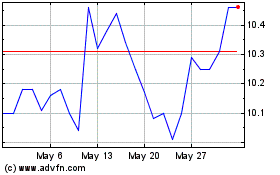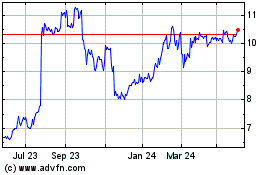Treasury Official Calls for Greater Foreign Bank Policies
March 07 2016 - 1:50PM
Dow Jones News
International regulators have made significant headway in
putting in place regulatory changes in the wake of the 2008
financial crisis, but the U.S. Treasury is continuing to push for
more policies to establish a level playing field between foreign
and U.S. banks, said Treasury Under Secretary for International
Affairs Nathan Sheets.
Mr. Sheets, who attended the Group of 20 meeting of finance
ministers and central bank governors in China late last month, said
the officials' agenda remains focused on bank capital and leverage,
the resolution of systemically important financial institutions,
stability in the shadow banking system and regulating
derivatives.
"My sense is that most of the heavy lifting on these reforms has
been completed," Mr. Sheets told the Institute of International
Bankers' annual conference in Washington. "However,
standard-setting bodies will continue to refine and calibrate the
capital and liquidity frameworks to promote coherence and
effectiveness." He added that the "Basel Committee has signaled
that it does not envision significantly increasing overall capital
standards from here."
Overall, Mr. Sheets said the regulatory changes adopted
following the financial crisis have made the financial system safer
despite recent market turbulence.
"Investors are more appropriately pricing the risk of debt
instruments and coming to terms with new expectations for banks'
return on equity," he said. "My assessment is that these important
steps greatly reduce the risk of systemic crises, while still
allowing banks to continue to play a critical role in
intermediating credit for the real economy."
Mr. Sheets seemed particularly concerned about how foreign
regulators are applying "uneven" changes that are "behind schedule"
to improve the trading and reporting of certain derivatives
contracts. He did, however, note a recent agreement between the
European Commission and the Commodity Futures Trading Commission to
allow U.S. central counterparties to continue providing clearing
services in the European market. He also expects some additional
guidance related to the central counterparties system before the
G-20 ministers and central bankers meet again in September.
"We continue to urge our fellow G-20 members to act on these
critical reforms to foster financial stability, reduce market
fragmentation, and support a level playing field for global firms,"
Mr. Sheets said. He also said the Financial Stability Board, the
international organization aimed at promoting financial stability,
is coordinating with member countries on central counterparties "so
that these crucial parts of the financial architecture are not
themselves too big to fail."
Further, he said, another priority is promoting financial
inclusion by lowering the costs and improving regulation of
international money transfers, or remittances.
Beyond that, he said, the Treasury is emphasizing financial
education and transparency along with greater disclosure
"particularly for those services designed to reach traditionally
excluded and underserved groups," and, to that end, is working with
international standards bodies.
Mr. Sheets also gave credit to regulators for developing
standards to avoid the "too big to fail" problem with financial
institutions. Known as total loss-absorbing capacity, or TLAC, the
standards require banks to increase their capital reserves and will
be phased in beginning in 2019.
"Analysis concludes that there will be sufficient demand for the
TLAC instruments that must be issued to satisfy the standard," he
said. "That said, the standard recognizes that emerging market
G-SIBs (global systemically important banks) may need additional
time to come into compliance due to their less developed domestic
bond markets."
Write to Rachel Witkowski at Rachel.Witkowski@wsj.com
(END) Dow Jones Newswires
March 07, 2016 13:35 ET (18:35 GMT)
Copyright (c) 2016 Dow Jones & Company, Inc.
Pacific Current (ASX:PAC)
Historical Stock Chart
From May 2024 to Jun 2024

Pacific Current (ASX:PAC)
Historical Stock Chart
From Jun 2023 to Jun 2024
